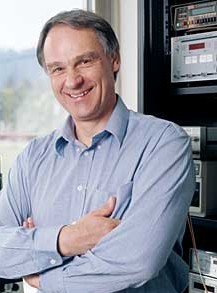-
(b.) - ?1947 July 20
Bio/Description
A German physicist, who won the Nobel Prize in Physics in 1986 for the invention of the scanning tunneling microscope, he was born in Frankfurt am Main and played in the ruins of the city during his childhood. His family lived partly in Frankfurt and partly in Offenbach am Main, and he attended school in both cities. At the age of 10, he decided to become a physicist, but he soon wondered whether he had made the right choice. He concentrated more on music, playing in a band. He also started playing the violin at 15 and played in his school orchestra. He studied physics at the J.W. Goethe University in Frankfurt, where he earned a Bachelor's degree in 1973 and he received his Ph.D. from the University of Frankfurt in 1978 within Werner Martienssen's group, supervised by Eckhardt Hoenig who invented the electron microscope. Also, in 1978, he accepted an offer from IBM to join their Z?rich research group, where he worked with Heinrich Rohrer, Christoph Gerber and Edmund Weibel. There they developed the scanning tunneling microscope (STM), an instrument for imaging surfaces at the atomic level. The Nobel committee described the effect that the invention of the STM had on science, saying that "entirely new fields are opening up for the study of the structure of matter." The physical principles on which the STM was based were already known before the IBM team developed the STM, but he and his colleagues were the first to solve the significant experimental challenges involved in putting it into effect. He, along with Gerber and Calvin Quate went on to develop the atomic force microscope (AFM). From 1986 to 1988 he was a Visiting Professor at Stanford University. In 1994 he founded Definiens which turned in the year 2000 into a commercial enterprise. The leading provider of image analysis and data mining solutions for life sciences, tissue diagnostics and clinical digital pathology, companies and institutions around the world use Definiens' technology to maximize the value of images and thereby enabling better decisions. The software provides detailed cell-by-cell readouts from target structures on whole tissue slides, and allows the correlation of this information with data derived from other sources, generating new knowledge and supporting better decisions in research, diagnostics and therapy. Definiens currently focuses on applications for Life Sciences and Earth Sciences. In Life Sciences, Definiens' technology is used to accelerate the drug discovery, development, and diagnostics processes. In Earth Sciences, Definiens' technology enables satellite and aerial image classification and analysis with greater speed, accuracy and insight. The Binnig and Rohrer Nanotechnology Center, an IBM-owned research facility in R?schlikon, Zurich is named after him and Heinrich Rohrer. The IBM Z?rich team was soon recognized with a number of prizes: the German Physics Prize, the Otto Klung Prize, the Hewlett Packard Prize and the King Faisal Prize. In 1986, he and Rohrer shared half of the Nobel Prize in Physics, the other half of the Prize was awarded to Ernst Ruska. In addition, he is the recipient or co-recipient of the 1984 EPS Europhysics Prize (with Heinrich Rohrer); the 1987 Elliott Cresson Gold Medal of the Franklin Institute (with Heinrich Rohrer); the National Inventors Hall of Fame in 1994; and in 1987 he was named an IBM Fellow, the highest honor a scientist, engineer, or programmer at IBM can achieve. He became a Member of the Board of Daimler Benz in 1990. He is the co-author of, ?Das Raster-Tunnelmikroskop (The Scanning Tunneling Microscope)? (1987, with Heinrich Rohrer); ?Aus dem Nichts (Out of Nothing)? (1989); and Kinder denken in Bildern (Children Think in Pictures) (1990, with Hans Daucher). He has two grown children and is married to his wife, Lore.
-
Date of Birth:
1947 July 20 -
Gender:
Male -
Noted For:
Co-inventor of the scanning tunneling microscope (STM), an instrument for imaging surfaces at the atomic level -
Category of Achievement:
-
More Info:


